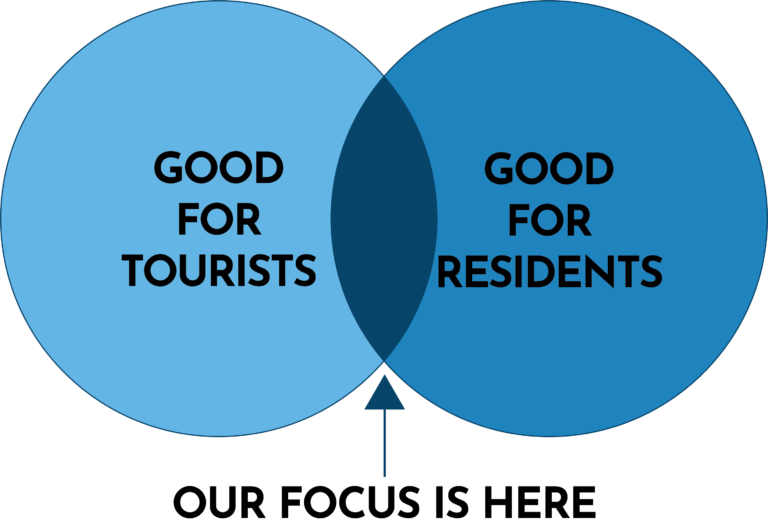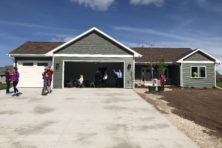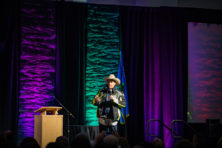Using Tourism Dollars to Build Better Communities
- Share
- Tweet
- Pin
- Share

April 6 is the first deadline for a new quarterly grant program designed for local projects and funded with $1.8 million
If you live or work in Door County, you’ve heard many times that “tourism exists to make our lives better” and “tourism works for us.” If it weren’t for tourism dollars, the mantra goes, Door County would not have its wealth of restaurants, shopping, galleries and arts, or all the jobs and livelihoods that those places support.
Depending upon people’s perspective, they either agree with this or they don’t – few are ambivalent. If seeing is believing, a new program that Destination Door County (DDC) launched this week has been designed to demonstrate the positive benefits of tourism in ways that local residents can experience.
DDC’s new Community Investment Fund (CIF) program will grant money to nonprofits, community business associations and local governments, but only if those projects benefit visitors and local residents.
“To get an application approved, you’re going to have to demonstrate how you’re having a meaningful impact on the people who live and work in Door County,” said Bret Bicoy, president and CEO of the Door County Community Foundation (DCCF), which will administer the grant program.
The CIF will be funded with a portion of the revenue generated from the 8% lodging tax visitors pay when staying overnight in Door County.
“We recognized the need for investment due to increased visitation and the stresses it provided our county for our visitors and the residents,” said Julie Gilbert, DDC’s president and CEO. “We wanted to be able to give back.”
Strengthening the connection between tourism dollars and a higher quality of life for local residents is also good business.
“Up until recently, we haven’t had our residents as the focus,” said Jon Jarosh, DDC’s chief communications officer. “For years, our focus was trying to get more people here, and that was the case [for destination marketing organizations] nationally.”
Although that’s still DDC’s primary goal, a more sustainable version of destination marketing means acknowledging that the peninsula supports not only visitors, but also a whole population of people who live and work in Door County.
“They have to be part of the conversation,” Jarosh said. “If they’re unhappy, it will reflect badly on us as a destination.”
To ensure that projects will benefit local residents, the CIF has five
priorities to guide grant applicants:
- Creative ideas that have a meaningful impact on the people who live and work in Door County
- Impact that crosses municipal boundaries
- Encourages collaboration
- Leverages additional resources
- Residents experience the positive impact of tourism
The more of these priorities applicants hit, the greater their project’s chance of receiving a grant. Examples would be projects that improve parks or public spaces.
“A trail is a perfect example [of] something [that is] certainly used by tourists, and yet that same trail system is used actively by year-round residents,” Bicoy said. “That’s a perfect example of something that benefits all of us. It needs to go beyond just serving the tourists.”
DDC committed roughly $800,000 to the fund in 2022, budgeted another $1 million for it in 2023, and anticipates it will grant a total $1 million annually. DDC has not committed to funding the program at a specific annual level in succeeding years, but neither is there a sunset clause to the quarterly grant program.
“Our anticipation, based on our board’s discussion, is this would be a long-term program,” Jarosh said. “How much money goes into that fund each year is what will fluctuate. If business is great, I think more money will go into that fund. If business starts to tighten up a little bit, it may drop a little bit.”
Gilbert said she anticipates an annual funding commitment of $1 million to the CIF.
“It’s something we’ve never done before,” she said. “I’m so excited; I feel like we can make a difference.”
Why This? Why Now?
David Eliot, the publisher, co-founder and co-owner of the Peninsula Pulse, engineered the movement to implement the room tax back in 2007 and also drove the effort to increase it from 5.5% to 8% effective Jan. 1, 2022. When describing the benefits the increased room tax would bring in a September 2021 editorial within these pages, Eliot alluded to a “new vision” of marketing Door County: one that reinvests in the peninsula’s communities to help sustain them.
“Yes, there will be more money for marketing, but if the Door County Tourism Zone Commission and Destination Door County stick to the new vision, what that marketing means can be something different than in the past,” Eliot wrote then. “Beyond marketing, there will be much more money for many things that will improve the lives of locals and visitors.”
There is much more money. The Door County Tourism Zone Commission (DCTZC) has collected more room-tax revenue in 2022 than ever before, with three months remaining to be accounted for: $9,111,191 through September 2022. By contrast, the DCTZC collected $7,279,397 in all of 2021; $4,781,817 during the pandemic-repressed year of 2020; and $5,139,717 in 2019. Final year-end 2022 numbers are not expected until about February 2023.
Thirty percent of all room-tax collections go back to the municipalities where the tax was collected for the local government to use in any way. Seventy percent goes to DDC. The CIF is one way to channel some of DDC’s share back into communities through projects that not only show tourism dollars at work, but “keep Door County whole and preserve the community and environment people have known and love,” Eliot said.
“The plan itself – for how it’s distributed – I didn’t have all that in mind [when first advocating a room-tax increase in 2020], but I was looking at some of those dollars coming back and rebuilding and maintaining those infrastructures and pieces of the tourism industry that have taken a big hit,” he said.
Eliot is also vice chair of the DCTZC and was a member of the Tourism Investment Grant Task Force that worked for months to create the CIF during planning sessions that Bicoy facilitated (see the sidebar).
Bicoy’s take on the program that emerged from those conversations is that it’s a “really refreshing reminder of the direction DDC is taking right now,” he said. “I just commend Destination Door County and the Tourism Zone for their desire to use tourist dollars in this way. It’s not about tourism. It’s about the community and those of us who live here. We’re going to use tourism for the people who live and work here.”
Room-tax Collections on the Rise
All Door County lodging providers collect an 8% room tax from visitors and remit it to the Door County Tourism Zone Commission (DCTZC). The DCTZC, by state statute, directs 70% of those collections to the entity it contracts with – in this case, Destination Door County – to market Door County in an effort to increase overnight stays. The remaining 30% goes back to the municipality where the room tax was collected for that community’s governmental body to use in any way it deems necessary.
The DCTZC collected $4,781,817 in room tax in 2020, and $7,279,397 by year-end 2021, according to the DCTZC’s financial audit report.
Starting on Jan. 1, 2022, the room tax increased to its current 8% from 5.5%. Through September 2022, $9,111,191 had been collected in room tax. Final year-end 2022 numbers are not expected until about February 2023.
Community Investment Fund Grant Program Basics
Destination Door County’s Community Investment Fund is a grant program for 501(c)(3) public charities, 501(c)(6) visitor centers and units of government that will be administered by the Door County Community Foundation (DCCF).
There is currently about $1.8 million in the fund – roughly $800,000 from 2022 and another $1 million budgeted for 2023. DDC intends to grant up to $1 million annually.
The grant cycle will run quarterly, with deadlines at 4 pm on the first Thursday of April, July, October and January. Applicants will be notified of a decision generally about a month after the application deadline.
Average grant requests anticipated are in the $100,000 range, with more modest amounts of $5,000 to $50,000 encouraged. Only one applicant per legal entity per grant cycle is allowed.
DCCF staff will examine grant applications to ensure that they comply with state statutes. Applications that pass that vetting will then be reviewed and selected by a DCCF grant committee whose members will remain anonymous.
“We do it this way to remove it from the politics and the pressure that can come when you’re dealing with large amounts of money,” said Bret Bicoy, DCCF president and CEO. “That’s why the foundation is a good vehicle.”
Political implications of decisions made by the DCCF grant committee will be considered by a new Governance Committee that will periodically review the grants awarded to help inform future decisions. The initial Governance Committee will be the members of the Tourism Investment Grant Task Force. The initial members of that task force are Fred Anderson, Mona Christensen, David Eliot, Tim Guckenberg, Louise Howson, Bjorn Johnson, Michelle Lawrie, Jeff Lutsey, Ken Pabich, Greg Stillman, Todd Trimberger, Britt Unkefer, Josh VanLieshout and Vicki Wilson.
Find more details and application materials at CommunityInvestmentFund.org.
Given that the Community Investment Fund must comply with statutory rules regarding the use of room-tax dollars, applicants are strongly encouraged to contact the DCCF for an informal assessment of their idea prior to submitting a formal application. Email [email protected], or call the DCCF at 920.746.1786 to schedule an appointment for such a discussion.






